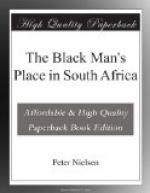The elementry instinct of self-preservation is no stronger in the Native than in the white man. Suicide is not at all uncommon among the Bantu. I have seen many instances of Natives who have shown a calm and philosophical disregard of death where life has seemed no longer desirable. This pre-eminently human prerogative—for no animal can rise to the conscious and deliberate destruction of itself—has often been exercised, as I have seen, by Natives in their sound and sober senses so as to preclude entirely that suggestion of temporary insanity which is so commonly accepted at coroner’s inquests in England and elsewhere.
The instinct of direction, the “bump of locality” as it is generally called, varies with the Natives as it does among the whites, and is no keener in the individual Native than in the individual white man. All the hunters and travellers I have met have confirmed the opinion I have myself formed from personal experience that by training his ordinary powers of observation and thereby developing his sense of locality and direction the average European is able, after a comparatively short time, to find his way in difficult country as well as the Natives, while some European hunters who have dispensed with Native guides and trackers have acquired the art of tracking game so well that they surpass even the local Natives themselves. “Veld-craft” is simply a matter of training the ordinary faculties of observation and memory for particular purposes, and the Native shows no such superiority in this respect as would naturally be expected from him if he were indeed better provided with animal instincts than the more civilised white man.
The sexual instincts of the Natives seem in no wise different from those of other people. The African male, like the European male, is generally more amative than the female who is always more philoprogenitive than the man. But the notion is common that the Native male is more bestial when sexually excited than the white man in similar case, and this is taken to account for the fact that he is so often found guilty of crimes of violence against females of his own colour, and sometimes even against European women.
It must be borne in mind that before the white man came the Natives, like the peasants in many European countries not long ago, conducted their courtship and love-making with a show of violence which seemed to them right and proper. The idea, indeed, that any self-respecting Native girl could yield herself to a lover without, at least, a semblance of physical resistance, leading to her more or less forcible capture by the man, would have seemed, and still seems, distinctly improper to the majority of Native women in their raw state. But since the European code was set up Native women have not been slow in making use of its protection, and, as I have seen, have not infrequently abused that protection by alleging rape or assault where their own action in simulating flight and resistance served, as they well knew it would, to stimulate passion and pursuit.




